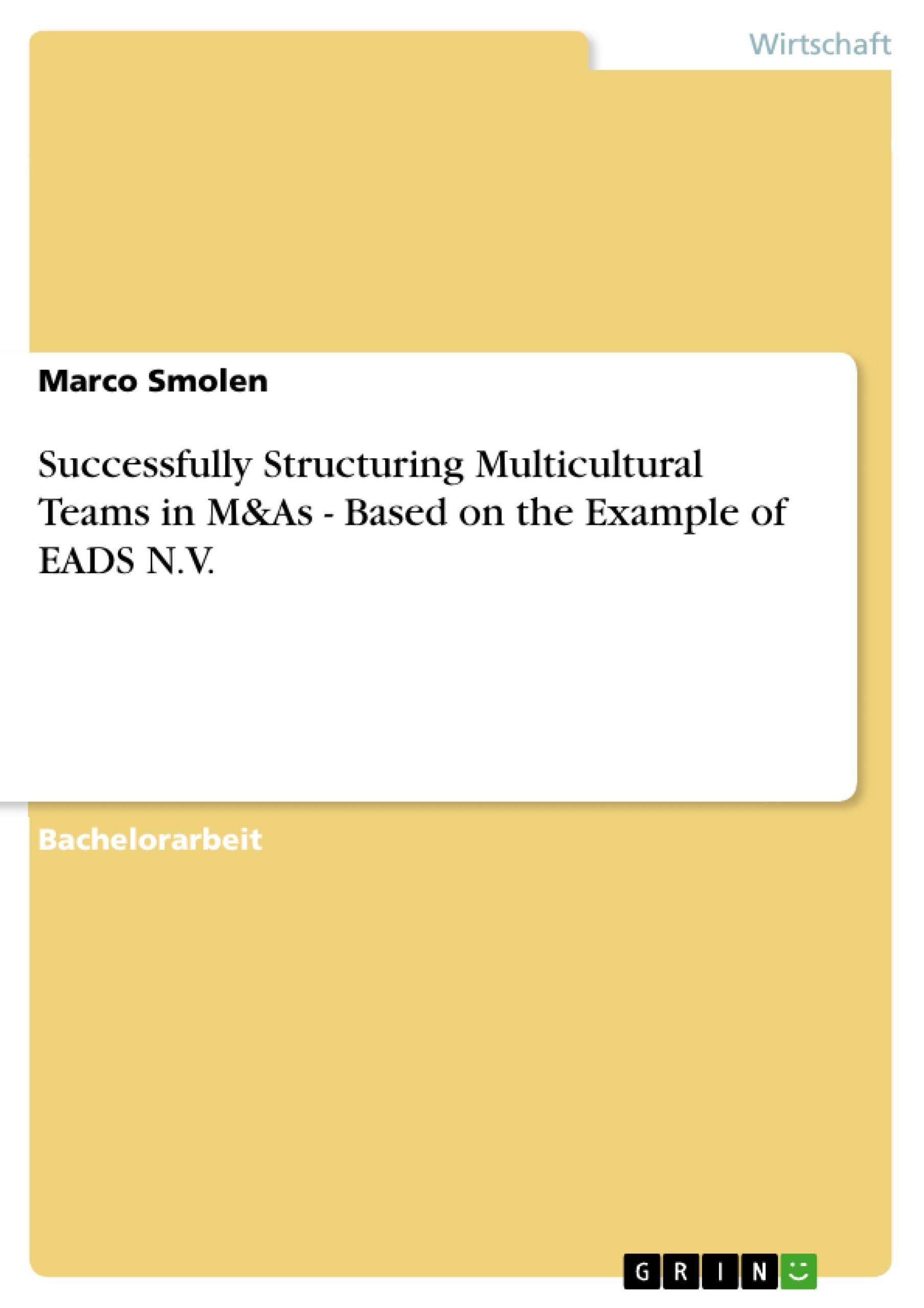This bachelor thesis gives information on how to succeed with teamwork in a cross-border and multicultural context, which is of major importance in the case of international mergers and acquisitions (M&As). A company’s management and people in charge of international teams not only face cultural diversity and the implications that come with it, but also the question of how to get teams to be most effective. What kind of leadership is most appropriate for teams and what factors influence teams in their efficiency are two of the most important questions to be answered. For that reason the present thesis concentrates on some of the major theories on M&As, culture, leadership, and team effectiveness and applies them to a practical example: European Aeronautic Defence and Space Company N.V. (EADS), a company that emerged from three culturally different companies in 2000 and that faced and still faces the challenges mentioned above. People from France, Germany, and Spain now need to work together to accomplish common goals, often by means of teamwork. The reader gets to know how EADS perceives and handles cultural diversity, exercises leadership, and achieves team effectiveness. The theory elements selected before serve as a guideline to see how EADS’ actions affected the challenges they faced. These findings from secondary sources together with in-depth interviews with a senior executive at EADS and other experts on multicultural teamwork provide the basis for recommendations on how to cope with cultural diversity after a merger or acquisition. These especially focus on what should be considered in this respect to make the transaction succeed after all. Critical comments and an outlook are added by the author at the end of this research paper.
Inhaltsverzeichnis
- Preface
- Content
- List of Abbreviations
- List of Tables and Figures
- 1 Introduction
- 1.1 Executive Summary
- 1.2 Scope of Work
- 2 Problem
- 2.1 Definition of Problem
- 2.1.1 The need for Teams in a Merger or Acquisition
- 2.1.2 Cross-Cultural Challenges in Teams
- 2.1.3 Team Effectiveness
- 2.2 Reasoning and Motivation
- 2.3 Research Methods
- 2.1 Definition of Problem
- 3 Relevant Theories
- 3.1 Mergers and Acquisitions
- 3.1.1 Definition, Types, and Phases
- 3.1.2 Theories for Mergers and Acquisitions
- 3.1.2.1 Transaction Cost Theory
- 3.1.2.2 Agency Theory
- 3.1.2.3 Strategy
- 3.1.2.3.1 Resource-based View
- 3.1.2.3.2 Knowledge-based View
- 3.2 Culture
- 3.2.1 Definition
- 3.2.2 Theories for Culture
- 3.2.2.1 Kluckhohn / Strodtbeck
- 3.2.2.2 Hall
- 3.2.2.3 Hofstede
- 3.2.2.4 Trompenaars
- 3.2.2.5 Dülfer
- 3.2.2.6 GLOBE
- 3.3 Leadership
- 3.3.1 Definition and Approaches
- 3.3.2 Theories for Leadership
- 3.3.2.1 Blake and Mouton's Managerial Grid Model
- 3.3.2.2 Lewin's Leadership Styles
- 3.3.2.3 Likert's Leadership Styles
- 3.3.2.4 French and Raven Power Taxonomy
- 3.3.2.5 Social Exchange Theory
- 3.3.2.6 Strategic Contingencies Theory
- 3.3.2.7 Fiedler's Contingency Model
- 3.3.2.8 House's Path-Goal Theory
- 3.3.2.9 Vroom-Yetton / Vroom-Jago Model
- 3.4 Teams
- 3.4.1 Definition
- 3.4.2 Theories for Teams
- 3.4.2.1 Tuckman's Model of Group Development
- 3.4.2.2 Gersick's Punctuated Equilibrium Model
- 3.4.2.3 Belbin's Team Roles
- 3.4.2.4 Hackman's Team Effectiveness Model
- 3.4.2.5 Guzzo & Shea's Team Effectiveness Model
- 4 Selected Theory Elements
- 4.1 Geert Hofstede's Culture Value Dimensions
- 4.1.1 Power Distance
- 4.1.2 Individualism versus Collectivism
- 4.1.3 Masculinity versus Femininity
- 4.1.4 Uncertainty Avoidance
- 4.1.5 Long-Term versus Short-Term Orientation
- 4.2 Likert's Leadership Styles
- 4.2.1 Exploitative Authoritative
- 4.2.2 Benevolent Authoritative
- 4.2.3 Consultative
- 4.2.4 Participative
- 4.3 Hackman's Team Effectiveness Model
- 4.3.1 Real Team
- 4.3.2 Compelling Direction
- 4.3.3 Enabling Structure
- 4.3.4 Supportive Organizational Context
- 4.3.5 Expert Coaching
- 4.1 Geert Hofstede's Culture Value Dimensions
- 5 Case - European Aeronautic Defence and Space Company N.V.
- 5.1 The Multinational Merger of EADS
- 5.1.1 About EADS
- 5.1.2 The Merger in 2000
- 5.2 Application of Selected Theory Elements
- 5.2.1 Hofstede's Culture Value Dimensions
- 5.2.1.1 French Culture
- 5.2.1.2 German Culture
- 5.2.1.3 Spanish Culture
- 5.2.2 Likert- Leadership Styles
- 5.2.3 Hackman's Team Effectiveness Model
- 5.2.1 Hofstede's Culture Value Dimensions
- 5.3 Findings and Interpretation of Expert Interviews
- 5.3.1 Culture
- 5.3.2 Leadership
- 5.3.3 Teams
- 5.4 Solution of Case Problem
- 5.1 The Multinational Merger of EADS
- 6 Conclusion / Critical Comments / Outlook
Zielsetzung und Themenschwerpunkte
Die vorliegende Bachelorarbeit untersucht die Auswirkungen kultureller Diversität auf Teams in Fusionen und Übernahmen. Die Arbeit basiert auf dem Beispiel von EADS N.V. und zielt darauf ab, die Herausforderungen und Chancen der Zusammenarbeit in multinationalen Teams in diesem Kontext zu analysieren.
- Kulturelle Diversität in multinationalen Teams
- Theorien zu Fusionen und Übernahmen
- Theorien zu Kultur und Führung
- Team-Effektivität in multinationalen Kontexten
- Fallstudie EADS N.V. und Analyse der kulturellen Dimensionen, Führungsstile und Teamarbeit
Zusammenfassung der Kapitel
Das erste Kapitel bietet eine Einleitung in das Thema und stellt den Forschungsrahmen vor. Kapitel 2 definiert das Problem der kulturellen Diversität in Teams bei Fusionen und Übernahmen, beleuchtet die Motivation für die Forschung und beschreibt die angewendeten Methoden. Kapitel 3 präsentiert relevante Theorien zu Fusionen und Übernahmen, Kultur, Führung und Teamarbeit. Kapitel 4 greift ausgewählte Elemente aus den Theorien auf, um die Analyse in Kapitel 5 zu ermöglichen. Kapitel 5 fokussiert auf die Fallstudie EADS N.V. und analysiert die kulturellen Dimensionen, Führungsstile und Teamarbeit anhand der ausgewählten Theorien.
Schlüsselwörter
Die Arbeit konzentriert sich auf die Themenbereiche kulturelle Diversität, Fusionen und Übernahmen, multinationales Teamwork, Team-Effektivität, Führungsstile, Kulturdimensionen und die Fallstudie EADS N.V. Sie beschäftigt sich mit Theorien von Hofstede, Likert und Hackman sowie relevanten Ansätzen zur Analyse der Zusammenhänge zwischen Kultur, Führung und Teamarbeit in multinationalen Kontexten.
- 3.1 Mergers and Acquisitions
- Citation du texte
- Marco Smolen (Auteur), 2006, Successfully Structuring Multicultural Teams in M&As - Based on the Example of EADS N.V., Munich, GRIN Verlag, https://www.grin.com/document/57468



